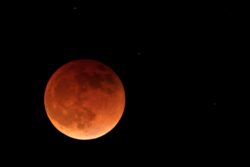The next total lunar eclipse will not occur until March 14, 2025 (Picture: AP Photo/Ted S. Warren)
A total lunar eclipse is set to take place tomorrow and it will be the last one till 2025.
This is the second total lunar eclipse this year after the previous total lunar eclipse in May 16.
According to Nasa, at least a portion of the 8th November eclipse will be visible throughout eastern Asia, Australia, the Pacific, and North America.
Sadly, the Royal Observatory Greenwich has said that the total lunar eclipse will not be visible in the UK.
Viewers in the United States and Canada will need to rise bright and early to catch the show, as the first phase of the eclipse will begin at 4:09 a.m. EST (0900 GMT).
A total lunar eclipse is set to take place tomorrow and it will be the last one till 2025 (Picture:Nasa)
The peak of the eclipse — known as totality, when the entirety of the moon’s visible surface is shrouded by the Earth’s shadow — will occur from 5:16 to 6:43 a.m. EST (1016 to 1143 GMT) and then slowly brighten as a partial eclipse for the following hour, according to Nasa.
The next total lunar eclipse will not occur until March 14, 2025.
According to Alphonse Sterling, a Nasa astrophysicist, total lunar eclipses occur approximately once every 1.5 years on average.
What is a total lunar eclipse?
A lunar eclipse happens when the moon’s orbit moves in front of the Earth’s shadow, preventing the sun’s light from reaching it.
A total lunar eclipse occurs when Earth casts a complete shadow – called an umbra – over the Moon.
During a total lunar eclipse, the Moon and the Sun are on opposite sides of Earth. Lunar eclipses are only possible when the orbits align so that the Moon is directly behind Earth relative to the Sun.
Another highlight of a total lunar eclipse is the Moon’s red hue during totality. The red color occurs because of the refraction, filtering, and scattering of light by Earth’s atmosphere.
The scattering is a phenomenon called Rayleigh scattering – named after the 19th-century British Physicist Lord Rayleigh.
Rayleigh scattering is also the reason for red sunrises and sunsets. Light from the Sun collides into the gases of Earth’s atmosphere and because of its shorter wavelength, blue light is filtered out, but red light is not easily scattered because of its longer wavelength.
Some of that red light is refracted, or bent, as it passes through Earth’s atmosphere and ends up shining on the Moon with a ghostly red light. The degree of redness of a fully eclipsed Moon can be influenced by atmospheric conditions resulting from volcanic eruptions, fires, and dust storms.
MORE : A quarter of the sun was blocked by a solar eclipse this morning
MORE : Children buried in sand during solar eclipse as relatives believe it will heal them
Sadly, it won’t be visible in the UK.





